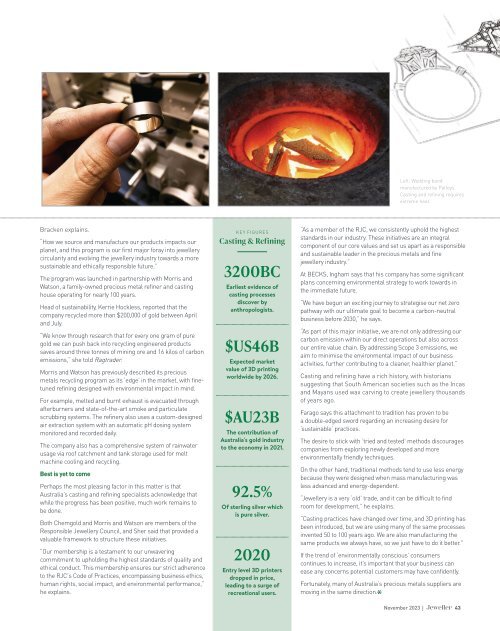Jeweller - November 2023
Create successful ePaper yourself
Turn your PDF publications into a flip-book with our unique Google optimized e-Paper software.
Left: Wedding band<br />
manufactured by Palloys.<br />
Casting and refining requires<br />
extreme heat.<br />
Bracken explains.<br />
“How we source and manufacture our products impacts our<br />
planet, and this program is our first major foray into jewellery<br />
circularity and evolving the jewellery industry towards a more<br />
sustainable and ethically responsible future.”<br />
The program was launched in partnership with Morris and<br />
Watson, a family-owned precious metal refiner and casting<br />
house operating for nearly 100 years.<br />
Head of sustainability, Kerrie Hockless, reported that the<br />
company recycled more than $200,000 of gold between April<br />
and July.<br />
“We know through research that for every one gram of pure<br />
gold we can push back into recycling engineered products<br />
saves around three tonnes of mining ore and 16 kilos of carbon<br />
emissions,” she told Ragtrader.<br />
Morris and Watson has previously described its precious<br />
metals recycling program as its ‘edge’ in the market, with finetuned<br />
refining designed with environmental impact in mind.<br />
For example, melted and burnt exhaust is evacuated through<br />
afterburners and state-of-the-art smoke and particulate<br />
scrubbing systems. The refinery also uses a custom-designed<br />
air extraction system with an automatic pH dosing system<br />
monitored and recorded daily.<br />
The company also has a comprehensive system of rainwater<br />
usage via roof catchment and tank storage used for melt<br />
machine cooling and recycling.<br />
Best is yet to come<br />
Perhaps the most pleasing factor in this matter is that<br />
Australia’s casting and refining specialists acknowledge that<br />
while the progress has been positive, much work remains to<br />
be done.<br />
Both Chemgold and Morris and Watson are members of the<br />
Responsible <strong>Jeweller</strong>y Council, and Sher said that provided a<br />
valuable framework to structure these initiatives.<br />
“Our membership is a testament to our unwavering<br />
commitment to upholding the highest standards of quality and<br />
ethical conduct. This membership ensures our strict adherence<br />
to the RJC's Code of Practices, encompassing business ethics,<br />
human rights, social impact, and environmental performance,”<br />
he explains.<br />
K E Y FIGURES<br />
Casting & Refining<br />
3200BC<br />
Earliest evidence of<br />
casting processes<br />
discover by<br />
anthropologists.<br />
$US46B<br />
Expected market<br />
value of 3D printing<br />
worldwide by 2026.<br />
$AU23B<br />
The contribution of<br />
Australia's gold industry<br />
to the economy in 2021.<br />
92.5%<br />
Of sterling silver which<br />
is pure silver.<br />
2020<br />
Entry level 3D printers<br />
dropped in price,<br />
leading to a surge of<br />
recreational users.<br />
“As a member of the RJC, we consistently uphold the highest<br />
standards in our industry. These initiatives are an integral<br />
component of our core values and set us apart as a responsible<br />
and sustainable leader in the precious metals and fine<br />
jewellery industry.”<br />
At BECKS, Ingham says that his company has some significant<br />
plans concerning environmental strategy to work towards in<br />
the immediate future.<br />
“We have begun an exciting journey to strategise our net zero<br />
pathway with our ultimate goal to become a carbon-neutral<br />
business before 2030,” he says.<br />
“As part of this major initiative, we are not only addressing our<br />
carbon emission within our direct operations but also across<br />
our entire value chain. By addressing Scope 3 emissions, we<br />
aim to minimise the environmental impact of our business<br />
activities, further contributing to a cleaner, healthier planet.”<br />
Casting and refining have a rich history, with historians<br />
suggesting that South American societies such as the Incas<br />
and Mayans used wax carving to create jewellery thousands<br />
of years ago.<br />
Farago says this attachment to tradition has proven to be<br />
a double-edged sword regarding an increasing desire for<br />
‘sustainable’ practices.<br />
The desire to stick with ‘tried and tested’ methods discourages<br />
companies from exploring newly developed and more<br />
environmentally friendly techniques.<br />
On the other hand, traditional methods tend to use less energy<br />
because they were designed when mass manufacturing was<br />
less advanced and energy-dependent.<br />
“<strong>Jeweller</strong>y is a very ‘old’ trade, and it can be difficult to find<br />
room for development,” he explains.<br />
“Casting practices have changed over time, and 3D printing has<br />
been introduced, but we are using many of the same processes<br />
invented 50 to 100 years ago. We are also manufacturing the<br />
same products we always have, so we just have to do it better."<br />
If the trend of ‘environmentally conscious’ consumers<br />
continues to increase, it’s important that your business can<br />
ease any concerns potential customers may have confidently.<br />
Fortunately, many of Australia’s precious metals suppliers are<br />
moving in the same direction.<br />
<strong>November</strong> <strong>2023</strong> | 43

















